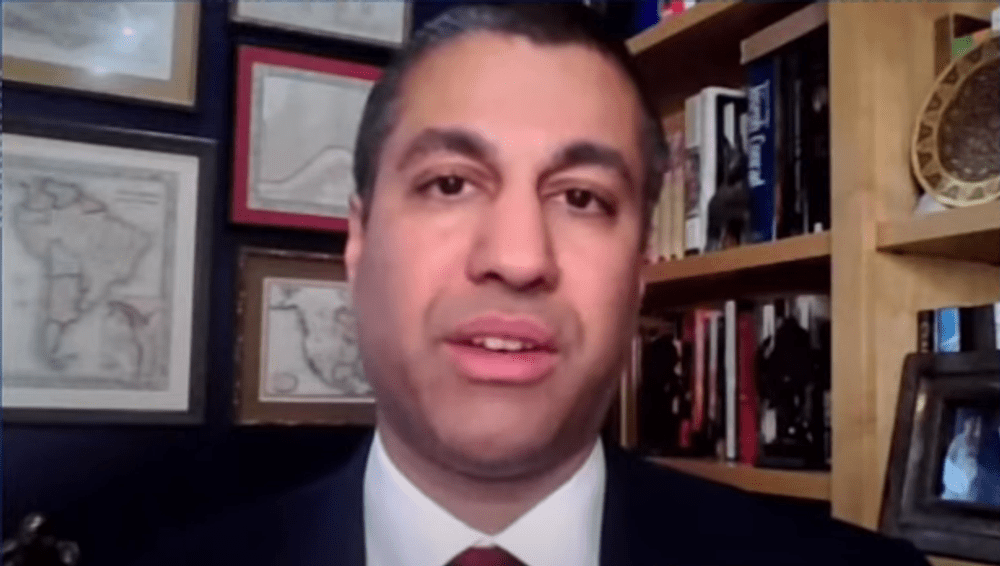FCC Chair Ajit Pai Says U.S. Sentiment Towards China Changed Under Trump
January 8, 2021 — Outgoing Federal Communications Commission Chairman Ajit Pai recalled a shift in American views towards China, which he says largely occurred over the course of his past four years in office, during an interview with the Center for Strategic and International Studies on Wednesday.
Jericho Casper

January 8, 2021 — Outgoing Federal Communications Commission Chairman Ajit Pai recalled a shift in American views towards China, which he says largely occurred over the course of his past four years in office, during an interview with the Center for Strategic and International Studies on Wednesday.
“The United States government’s orientation toward geopolitical threats and the FCC’s orientation toward national security were entirely different before I came into office,” said Pai.
The official position of the U.S. government during the previous Administration was that the United States “welcomes the rise of a China that is stable, prosperous and peaceful,” and that “our two great nations, if we work together, have an unmatched ability to shape the course of the century ahead.”
The Obama FCC issued a white paper on cybersecurity on January 18, 2017, two days before Inauguration Day, that didn’t mention China at all.
“Things are different now—much different,” said Pai, adding that Americans today hold increasingly negative views of China.
Pai referenced statistics, saying “In the U.S., the percentage of people with an unfavorable opinion of China increased from 60 percent to 73 percent over the past year.” He questioned where the sentiment came from.
The change may be a result of China ‘showing its hand’ over past years, as the People’s Republic of China aimed to have more of a stake in publicly-available technology. There is increasing recognition that the Chinese state government is using its growing influence over global commerce to become a leading international tech supplier.
In May 2015, China’s State Council issued Made in China 2025, a national strategic plan to further develop the manufacturing sector of the PRC, by upgrading the production capabilities of Chinese industries from labor-intensive workshops into more technology-intensive powerhouses.
To help achieve independence from foreign suppliers, the initiative encourages increased production in high-tech products and services, with its semiconductor industry central to the plan, partly because advances in chip technology may “lead to breakthroughs in other areas of technology, handing the advantage to whoever has the best chips.”
In response, in 2018, the Council on Foreign Relations, an American think tank, stated that MIC 2025 is a “threat to U.S. technological leadership.” In June 2018, the Trump administration imposed higher tariffs on Chinese goods, escalating trade tensions between China and the U.S. The tariffs primarily apply to the manufactured goods included in the MIC 2025 plan, such as those integral to IT and robotics industries.
Pai’s FCC has played a known role in promoting anti-China rhetoric. Over the past four years, the FCC has gone from essentially not acknowledging China to holding a bipartisan consensus that the PRC poses national security threats to U.S. communications infrastructure.
The Trump FCC has hyper-focused on issues related to larger, geopolitical U.S.-China altercations, such as Pai’s ‘Rip and Replace’ and ‘open radio access networks’ initiatives, promotion of rhetoric surrounding a ‘5G race’, signaled approval of blocking TikTok and WeChat, and more.
Under Pai, the FCC prompted and largely completed ‘Rip and Replace’ initiatives, which barred, and further ordered the removal, of telecommunications equipment from Chinese manufacturers, like Huawei and ZTE, in U.S. networks.
Pai’s FCC further prioritized streamlining 5G deployments, through pole citing and other infrastructure provisions, in what became the ‘race to 5G’ between the U.S. and China. Pai’s open RAN initiative, announced in September 2020, mirrors MIC 2025, in the sense that it attempts to reignite American tech manufacturers to lead in software and hardware development to support 5G.
“As part of the FCC’s 5G FAST Plan, the agency has taken many actions to promote American leadership in next generation wireless services,” said Pai. “To that end, we want the United States to lead the way in researching and developing innovative approaches to mobile network deployment.”
Pai says U.S. manufacturers are having a hard time competing with Huawei
“As this market has consolidated, Huawei is in a position of strength,” said Pai.
In conversation with CSIS President and CEO John Hamre, Pai compared American company’s attempting to compete with Huawei, which is directly subsidized by the Chinese government, to fighting with “one-hand tied behind your back.”
“China’s subsidizes Huawei which gives them a leg up,” said Pai, adding that Huawei wireless equipment is often 30 to 70 percent cheaper than technology from competitors Ericcson and Nokia.
“We’re trying to address things defensively, by taking Huawei equipment out,” said Pai, going on to detail the U.S. strategy for a strong offense. “Given that we have an advantage in software, and given that open RAN technologies generally have shown great promise, why don’t we pursue that area as well to enable us to break that consolidation, which has given Huawei an advantage.”
Pai noted that in order to compete with Huawei, the U.S. must build at a certain scale, and continually invest in research and development.










Member discussion